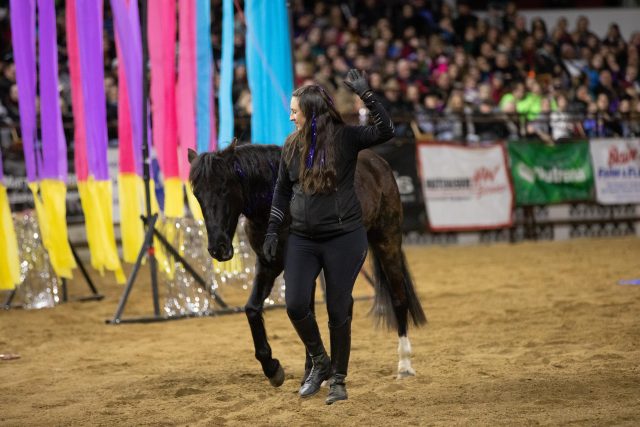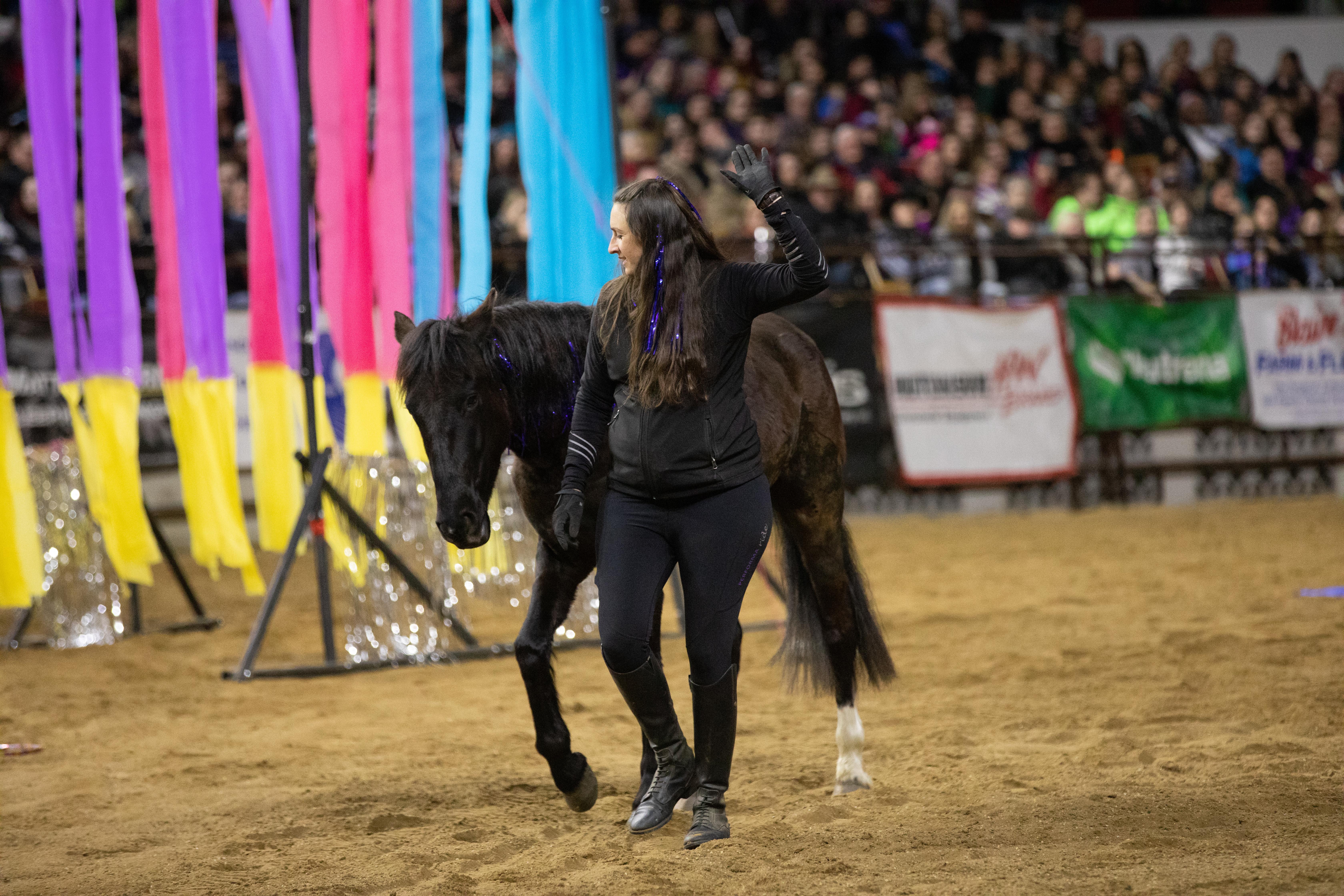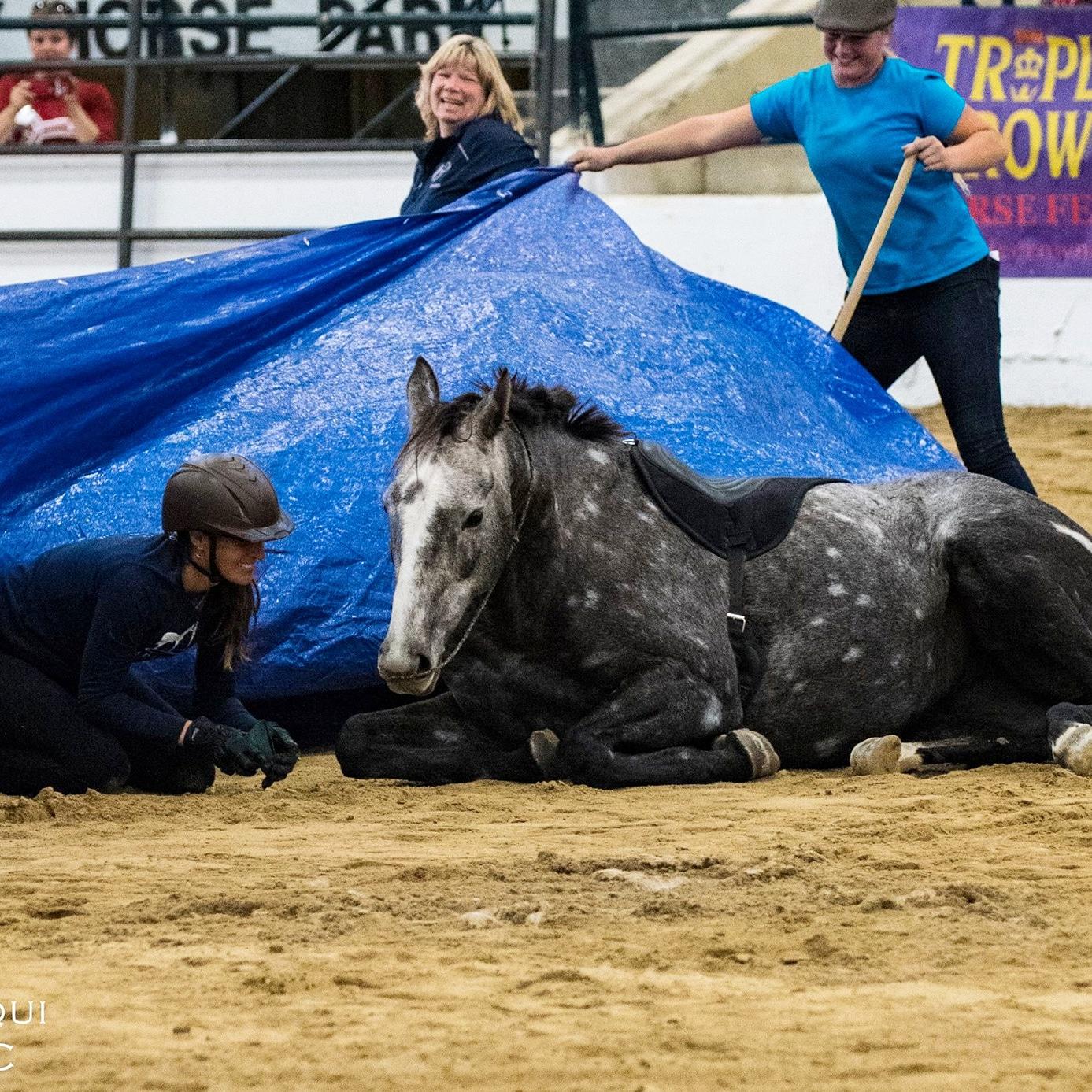
Horsemanship With Lindsey Partridge: A Mustang vs. Thoroughbred Makeover
Two popular training competitions — the Mustang and the Thoroughbred Makeovers — are bucket-list competitions for many horsepeople. Lindsey Partridge, a participant in both, shares her experience to give readers an exclusive inside look.
I did it – this month I competed in my first Mustang Makeover at the Midwest Fair in Wisconsin. What an amazing experience! I was thrilled to be first in Handling, second in Trail, fourth in Pattern, Legends Champion (over age 30 category), and overall reserve champion. My junior student, Franny, ended up finishing 12th overall (also her first Mustang Makeover).
There were about 40 competitors with adults and youth competing against each other.
At the same time while training my mustang Arwin, I’m also prepping two Thoroughbreds for my fifth Thoroughbred Makeover, put on by the Retired Racehorse Project. I’ve competed in three Thoroughbred Makeovers and judged freestyle at one as well; the Thoroughbred Makeover is held in Kentucky the first week of October.
I’ve definitely got more experience with Thoroughbred Makeovers at this point, with four out of six of the horses I’ve competed making the top three in both of their disciplines, and the other two horses making the top three for one of their disciplines and top ten in their other. I’m also a three-time discipline champion and was the winner of the overall title of America’s Most Wanted Thoroughbred in 2015 with my horse Soar (we call her Kahleesi at home).
I’m going to shed some light on competing in a Makeover challenge and the differences between a Mustang or Thoroughbred Makeover.
Choosing your horse
There are many mustang challenges hosted throughout the United States. Each one is a little different because it depends who is hosting and what funding they received. In general, the way you pick a mustang is based on a lottery system or picking order. Sometimes it is based on the order applications were received.
There is a group of mustangs to select from; you are shown a picture (sometimes you are lucky and you see more than one picture) and some very basic details like the age and which herd they were rounded up from.
For my challenge we sent in our top 14 picks, and then were told which one we received. Arwin was my #4 pick.
There are some downsides to this: for example, one girl in the mustang competition went to pick up her gelding and once she got it home she realized it was lame with an unknown prognosis. There is no way to do a pre-sale vet check other than getting a Coggins and health certificate. They definitely do their best to make sure the horses for the challenge are sound, but you really have no way to know what the movement, athletic ability, or temperament of your mustang is until you get it home. In some cases you might be able to book an appointment to go visit the holding facility ahead of time, but you don’t know which horse you will end up with.
For the Thoroughbred Makeover, you can purchase your retired racehorse from anywhere as long as it meets the eligibility criteria (which includes having a published work or last race within a certain time period, and not starting any training for a new discipline prior to December 1 before the competition year).
This means you have a lot of selection and can choose a horse that suits what you are looking for. For me, I’ve always bought my Thoroughbreds from pictures/jog videos and never go see them ahead of time. I am really confident in Harmony Horsemanship to retrain any racehorse, and I am willing to adjust my discipline to the horse so really I just care about them being sound.
That’s another perk to buying privately with the Thoroughbred Makeover — you can do vet exams if you want to. With my horse Fairly for this year’s makeover, I did x-rays because as a two-year-old old she fractured her pastern bone and I wanted to make sure it was healing properly.
The downside to purchasing a Thoroughbred is that they cost a lot more than a mustang – the mustang adoption fee was $125 for adults and only $25 for youth, whereas my Thoroughbreds I buy are usually around $1500 and it’s not uncommon for people to spend more than that on a nice one.
Level Playing Field
For both Makeovers, anyone can apply, and trainers are approved based on selection criteria which is pretty inviting. This means you can have an amateur competing against an Olympian, or a first time trainer competing against a veteran of several competitions.
I like this aspect of a Makeover competition – everyone starts with a fresh slate no matter your background, and everyone competes against each other as equals.
In 2015 I was called “the train they didn’t see coming” at the Thoroughbred Makeover because I wasn’t well known then — I showed up and won first and second in Trail, third and tenth in Freestyle, and the overall title of America’s Most Wanted Thoroughbred with my horses Soar and Lion of Wallstreet.
The one downside to the Thoroughbred Makeover now is how the overall winner is chosen. The year I won in 2015, it was determined by a panel. Ever since then, it has changed to audience applause or text message vote. I have given my feedback every year that I don’t like this, because it means the little unknown guy like I was back in 2015 is unlikely to win the overall title again because people with a large social network definitely have an advantage.
For the Mustang Makeover, there was a fan favorite award determined by applause, but the overall placings and title was determined by our scores combined over the whole competition. I like that much better because it stays objective and fair.
For the Mustang Makeover, sometimes youth and adults are separated. Youth only compete in hand, and adults compete under saddle, unless it is a competition where youth and adults compete against each other in which case both youth and adults compete in hand. At my most recently-attended Mustang Makeover, there were separate overall awards for the three age groups of youth, young adults (18-30), and legends (30+).
The Thoroughbred Makeover has youth, amateurs and professionals compete against each other, but there are separate top awards for each discipline for youth and amateurs.
The First Week
The first week for a mustang versus a Thoroughbred is very different. This is perhaps where getting a mustang is very limiting for some people. For starters, you can’t just go get your mustang and lead it onto a trailer. You need an open or stock trailer without a ramp and the horse will be “chased” on.
When you unload the mustang you need to have a chute set up to corral the horse because you can’t just lead it to a paddock or stall. The pen for your mustang needs to be about six feet tall because mustangs can actually jump quite high and if they do jump out you will have one tough time getting them back if they aren’t tame yet. It’s best if the area isn’t too big, unless you would like some extra exercise while trying to tame your horse.
Getting a Thoroughbred is much easier – you can load them onto a trailer (most load easily), you can lead them into a stall, they can go into a “normal” paddock, and generally the average staff person can care for them. No special skills required.
A mustang is a little harder – they aren’t used to being handled. In the beginning you want to be very careful who is handling your mustang because they can very easily ruin your training if they aren’t able to catch/lead/handle the horse and are helping with feeding, etc. A lot of times, people can mean well but if they are trying to pet/touch your mustang and are unsuccessful or do something to spook your horse then they actually make things worse.
The Training Process
Retraining an off the track Thoroughbred is a lot different than a mustang. Thoroughbreds are very athletic and have been training to run. They often have a lot of experience for basic skills for being handled and ridden, but they tend to have a lot of energy and will think they are supposed to be fast. To retrain a Thoroughbred, effectively you need to direct their energy. I love them because I have endless ideas of what to do with the energy and I enjoy teaching them many things. I love the work ethic that Thoroughbreds have, and I find slow horses kind of boring.
Mustangs, on the other hand, at least the two that Franny and I trained for this Makeover (I have also trained some mustangs outside of the Makeover) tend to be lower energy and need to develop a work ethic. Most of the mustangs I have trained are smart and very trainable, but also lazy and need to be motivated and taught to maintain a canter. They are extremely capable, they just tend to want to conserve their energy compared to a Thoroughbred.
Mustangs are harder in the beginning to train because your timing and feel need to be very good if you want to establish the first touch and halter. Thoroughbreds are easier in the beginning I think because you can already do so much with them. Overall both breeds have a lot of nice qualities.
The Competition
The mustang makeover has mandatory classes that everyone does to determine the top ten. The top ten also do a freestyle. The mandatory classes include a pattern with basic movements, handling and conditioning (which includes trailer loading, picking up feet, etc), and a trail class (which includes some common obstacle tasks). One thing to consider for the Mustang Makeover is that you need to prepare a freestyle knowing you might not get to do it unless you make top ten.
The Thoroughbred Makeover lets you choose one or two disciplines from show hunter, show jumper, eventing, dressage, polo, barrel racing, ranch, trail, field hunter, or Ffeestyle. I myself have competed in field hunter, trail, and freestyle.
I like the idea of having a mandatory class that everyone does all of the same tasks, but I also like that the Thoroughbred makeover lets you choose which discipline(s) best suit your horse. It makes sense that they are different though — Thoroughbreds are already handled and they are ready to start second careers, whereas mustangs are wild and first need a set basic skills and gentling.
The Camaraderie
The Thoroughbred Makeover has a Facebook group just for RRP Trainers. It is a pretty funny group — supportive but also fun to be a part of. The Thoroughbred folk are just kind of nutty (in a good way), and I feel like everyone is out to have a good time with their horse.
The mustang challenge I took part in also had a private Facebook group for the event and some people shared their progress. It was very supportive and people answered logistical questions about the event. The mustang folk aren’t quite as hilarious as the Thoroughbred trainers, but then again I am new to the Mustang Makeover world.
Health
All of my Thoroughbreds live outside 24/7 and are barefoot. They all wear blankets in the winter and in cold rain, and most of them come in daily for grain and supplements. The ones that don’t have free choice minerals and salt outside as well as 24/7 hay.
Most of my Thoroughbreds all needed some massage, chiropractor, dental and Equi-Bow sessions to get them recuperated from their racing days. Some of my Thoroughbreds had weak hooves that needed ScootBoots to help transition them to barefoot — Soar in 2015 nearly didn’t make it to the Makeover because she kept suffering from abscesses. Now her hooves have grown out and she is a hardy horse that is low maintenance.
I find my Thoroughbreds often have weak or sore backs and benefit from their Accuhorsemat, and most of them show symptoms of ulcers which need to be treated and I put them on the Omega Alpha supplements of Biotic 8 and GastraFx to get their gut healthy.
My mustangs, on the other hand, have been fresh slates and didn’t need any ulcer treatment, chiropractor or massage. I still put them on the Omega Alpha supplements to support their digestion and gut health because training and showing can be stressful. The mustangs also need dental work and I still blanket in the winter because we live on a windy hill that can be -40 at times… it’s awful even with shelters.
I find it takes my Thoroughbreds about a year off the track before I would consider them hardy — it takes time for their hooves to grow out and soles to toughen, for them to adjust to outdoor living, and really thrive on minimal maintenance. Whereas the mustangs come pretty hardy already, used to being barefoot and handling different terrain in the field.
After the Makeover
The Thoroughbred Makeover has an optional sales listing program for trainers to market their horses if they are wanting to sell and advertise at the Makeover and online.
The Mustang Makeover sometimes has a mandatory auction or optional auction at the end of the challenge depending on how it was organized. For the challenge I did, the auction was optional and we were able to keep our adopted mustangs, and we can sell them in the future if we want to.
What you do with your horse after the Makeover really depends on you and the horse. A lot of Thoroughbreds excel at English or jumping disciplines and some even make it to the Olympics; others can be great all-around horses. I love them in our lesson program because they have such a great work ethic that they enjoy coming out with the kids for lesson after lesson.
Mustangs tend to be smaller in size and can be well suited to many things including pleasure riding, obstacle work, western dressage, and even jumping… but I don’t think you’ll see a mustang in the Olympics any time soon.
Both Franny and I really enjoyed the mustang challenge and I’ve already signed up for my next one which will be competing in Georgia in mid September (about 7 weeks after my due date!). I love my Thoroughbreds — you’ll be seeing me at the 2019 makeover with my horses Fairly Obvious and Regina Christina (Bling).
Video of Bling’s first ride since the race track:
Video of Fairly’s first ride since the race track:
Lindsey Partridge is the founder of Harmony Horsemanship and three-time discipline champion at the Retired Racehorse Project’s Thoroughbred Makeover. Follow her @LindseyPHH or visit www.LindseyPartridge.com.










Leave a Comment